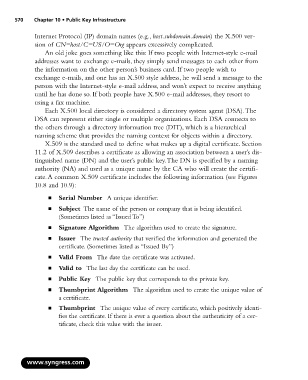Page 586 - StudyBook.pdf
P. 586
570 Chapter 10 • Public Key Infrastructure
Internet Protocol (IP) domain names (e.g., host.subdomain.domain) the X.500 ver-
sion of CN=host/C=US/O=Org appears excessively complicated.
An old joke goes something like this: If two people with Internet-style e-mail
addresses want to exchange e-mails, they simply send messages to each other from
the information on the other person’s business card. If two people wish to
exchange e-mails, and one has an X.500 style address, he will send a message to the
person with the Internet-style e-mail address, and won’t expect to receive anything
until he has done so. If both people have X.500 e-mail addresses, they resort to
using a fax machine.
Each X.500 local directory is considered a directory system agent (DSA).The
DSA can represent either single or multiple organizations. Each DSA connects to
the others through a directory information tree (DIT), which is a hierarchical
naming scheme that provides the naming context for objects within a directory.
X.509 is the standard used to define what makes up a digital certificate. Section
11.2 of X.509 describes a certificate as allowing an association between a user’s dis-
tinguished name (DN) and the user’s public key.The DN is specified by a naming
authority (NA) and used as a unique name by the CA who will create the certifi-
cate.A common X.509 certificate includes the following information (see Figures
10.8 and 10.9):
■ Serial Number A unique identifier.
■ Subject The name of the person or company that is being identified.
(Sometimes listed as “Issued To”)
■ Signature Algorithm The algorithm used to create the signature.
■ Issuer The trusted authority that verified the information and generated the
certificate. (Sometimes listed as “Issued By”)
■ Valid From The date the certificate was activated.
■ Valid to The last day the certificate can be used.
■ Public Key The public key that corresponds to the private key.
■ Thumbprint Algorithm The algorithm used to create the unique value of
a certificate.
■ Thumbprint The unique value of every certificate, which positively identi-
fies the certificate. If there is ever a question about the authenticity of a cer-
tificate, check this value with the issuer.
www.syngress.com

